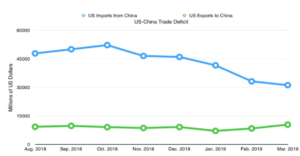Why the focus on China?
By The Policy Circle Team
The U.S. has levied tariffs against the EU, Canada, and Mexico, but negotiations and tariffs directed at China have taken center stage. Why? And what does this mean for free trade?
The Office of the U.S. Trade Representative investigated China’s trade practices and detailed how they operate:
- “The Chinese government uses foreign ownership restrictions…and other foreign investment restrictions to require or pressure technology transfer [i.e. the transfer of intellectual property] from U.S companies to Chineses entities” while Chinese companies do not face the same restrictive policies in the U.S.
- “The Chinese government has conducted and supported cyber intrusions into U.S. commercial networks targeting confidential business information held by U.S. firms.”
By “extracting intellectual property – sometimes coercively” and providing “market-disorienting subsidies to domestic industries,” China’s government is undercutting the competitive edge of U.S. companies. James Lewis of the Center for Strategic and International Studies further breaks down these issues and what they mean for trade.
In the meantime, after widening in 2018 the U.S. trade deficit with China has seen a steady reduction (in our favor) since November, 2018. A trade deficit is the difference between how much your country buys/imports from another country and how much your country sells/exports to that country. The jury of economic experts is still out on how muchtrade deficits matter – check out the Council on Foreign Relations’ backgrounder for more.

The increase in U.S. exports to China and decrease in imports from China shows that China is bearing the brunt of the tariff war. The U.S. is able to increase production at home and/or go elsewhere for many of the goods that we would otherwise import from China. China, on the other hand, has fewer places to turn since America is the biggest economy for importing Chinese goods. As a result, the Trump administration has doubled down since the beginning of 2018 on using tariffs to negotiate fairer trade practices and cut back the trade deficit. Check out this Reuters timeline for a full history of imposed tariffs.